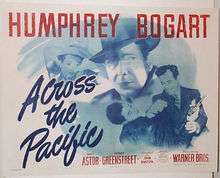Across the Pacific
| Across the Pacific | |
|---|---|
 | |
| Directed by |
John Huston Vincent Sherman |
| Produced by |
Jack Saper Jerry Wald |
| Screenplay by | Richard Macaulay |
| Based on |
"Aloha Means Good-bye" (1942 The Saturday Evening Post story) by Robert Carson |
| Starring |
Humphrey Bogart Mary Astor Sydney Greenstreet |
| Music by | Adolph Deutsch |
| Cinematography | Arthur Edeson |
| Edited by | Frank Magee |
| Distributed by | Warner Bros. |
Release dates |
|
Running time | 97 minutes |
| Country | United States |
| Language | English |
| Box office | $1.3 million (US rentals)[1][2] |
Across the Pacific is a 1942 American spy film set on the eve of the entry of the United States into World War II. The film was directed first by John Huston, then by Vincent Sherman after Huston joined the United States Army Signal Corps. It stars Humphrey Bogart, Mary Astor, and Sydney Greenstreet. Despite the title, the action of the film never progresses across the Pacific, concluding in Panama.
The title had been used before by Warner Brothers for a 1926 silent adventure film by the same name starring Monte Blue, who also has a small role in this film. However, the plots of the two films bear no resemblance to each other.
Initially, it was planned that the film would portray an attempt to avert a Japanese plan to bomb Pearl Harbor. When the real-life Pearl Harbor bombing occurred, the script was quickly rewritten to change the location of the planned attack to Panama.[3]
Director John Huston was called up to military service during filming; he claimed he left at the point near the end of the film in which Bogart is trapped in a house at gun-point. Vincent Sherman finished directing the film, minus the script which Huston took with him, explaining "Bogie will know how to get out". An implausible escape and plot wrap-up was shot, which Huston declared "lacked credibility".[4]
Plot
In late 1941, Captain Rick Leland (Humphrey Bogart) is court-martialed and discharged from the U.S. Coast Artillery after he is caught stealing. He tries to join the Canadian Army, but is coldly rebuffed. He subsequently boards a Japanese ship, the Genoa Maru, in Halifax, apparently to make his way to China via the Panama Canal to fight for Chiang Kai-shek.
On board, he meets Canadian Alberta Marlow (Mary Astor) and Dr. Lorenz (Sydney Greenstreet), a professor of sociology who makes no secret of his admiration of the Japanese and is thus not popular in the Philippines, where he resides. Leland, in his turn, makes it clear to Lorenz that he has no loyalty toward his country and would fight for anyone willing to pay him.
During a stop in New York, Leland, revealed as a secret agent trailing Lorenz, reports to Colonel Hart (Paul Stanton), an undercover Army Intelligence officer. Lorenz is a known enemy spy, but Hart and Leland are uncertain about Marlow. Upon returning to the ship, Leland surprises a Filipino man (Rudy Robles) who is about to shoot Lorenz, thus gaining Lorenz's confidence. Second-generation Japanese-American Joe Totsuiko (Victor Sen Yung) embarks as a passenger. Lorenz attempts to gather details from Leland concerning the military installations guarding the Panama Canal. Meanwhile, Marlow and Leland engage in a light-hearted romance.
As they arrive in Panama, the captain announces that the ship has been denied passage through the strategically vital canal and will be forced to take a long detour around Cape Horn. Leland, Marlow and Lorenz disembark to wait for another ship. Several crates are unloaded addressed to a Dan Morton at the Bountiful Plantation. Lorenz asks Leland, who was once stationed in the area, to procure up-to-date schedules for the American planes that patrol the canal. Leland meets with his local contact, A. V. Smith (Charles Halton), and convinces him to provide the real schedules, as Lorenz could easily find out if he were given fake ones. The date is December 6, 1941 - the eve of the attack on Pearl Harbor.
Having delivered the schedules after haggling with Lorenz over their price, Leland is knocked out. He wakes up several hours later and finds out that both Lorenz and Marlow have left the hotel. He immediately calls Smith and warns him to change the patrol schedule, then, on a tip from an informer (Philip Ahn) inside a movie theatre, heads out to the Bountiful Plantation, where he sees a torpedo bomber being prepared. He is captured, however, and brought inside to Lorenz, Marlow, and Totsuiko. Marlow turns out to be the daughter of the plantation's owner, Dan Morton (Monte Blue), a drunk whose weakness was exploited to provide a base for espionage activities. To Leland's relief, Marlow's only stake in the affair is concern for her father.
Lorenz reveals that they killed Smith before he could have the schedule changed, and that they are planning to torpedo the Panama Canal Locks. After Lorenz leaves for the landing field, Leland overpowers Totsuiko after the latter shoots Morton. Leland makes his way to the field where he takes over a machine gun and shoots down the bomber aircraft, piloted by no less than an Imperial Japanese prince, as it is about to take off. Leland dispatches Lorenz's men in the ensuing firefight. Returning to the house, he finds a defeated Lorenz attempting to commit seppuku, but his nerve fails him and he begs Leland to shoot him in the head. Leland refuses, saying his prisoner has "a date with Army intelligence."
Cast

- Humphrey Bogart as Rick Leland
- Mary Astor as Alberta Marlow
- Sydney Greenstreet as Dr. Lorenz
- Kam Tong as T. Oki, Lorenz's servant
- Charles Halton as A.V. Smith
- Victor Sen Yung as Joe Totsuiko [credited as Sen Young]
- Roland Got as Sugi
- Lee Tung Foo as Sam Wing On, Rick's friend
- Frank Wilcox as Captain Morrison
- Paul Stanton as Colonel Hart
- Lester Matthews as Canadian Major
- John Hamilton as Court-Martial President
- Roland Drew as Captain Harkness
- Monte Blue as Dan Morton
- Chester Gan as Captain Higoto
- Richard Loo as First Officer Miyuma
- Keye Luke as Steamship Office Clerk
- Rudy Robles as A Filipino Assassin
- Spencer Chan as Chief Engineer Mitsuko
- Tom Stevenson as Unidentified Man
- Philip Ahn as Informer inside theatre (uncredited)
Radio adaptation
Across the Pacific was adapted as a radio play on The Screen Guild Theater's January 25, 1943 broadcast with Bogart, Astor, and Greenstreet reprising their film roles.
Real unit
The opening scene shows 198th Coast Artillery Command at Governors Island, New York City. In fact the 198th Coast Artillery Regiment was stationed at Wilmington, Delaware.[5]
References
- ↑ "101 Pix Gross in Millions" Variety 6 Jan 1943 p 58
- ↑ Thomas Schatz, Boom and Bust: American Cinema in the 1940s Uni of California Press, 1999 p 218
- ↑ Astor, Mary - "A Life on Film", Dell Publishing 1967, New York, p157
- ↑ Huston, John - "An Open Book", Alfred A. Knopf, Inc. 1980, New York, p88
- ↑ 198th Signal Battalion Lineage
External links
- Across the Pacific at the TCM Movie Database
- Across the Pacific at the American Film Institute Catalog
- Across the Pacific at AllMovie
- Across the Pacific at the Internet Movie Database
- Across the Pacific on Screen Guild Theater: January 25, 1943